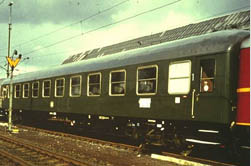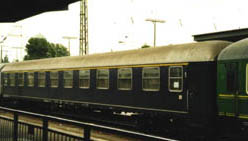Epoch III
Introduction
A new start
The first trains after the war
The first network of long-distance trains
Moving forward, more trains, more comfort, more regularity
Pre war rolling stock again in service
The start of an international long-distance network
The blue network of fast express trains
The modern era, the rise of electric locomotives
The modern diesel locomotive is coming
A new class of coaches
The third class is abandoned
The last new steam engine
A new prestious network, the Trans Europ Express
The Rheingold, from 1962 again exclusive
A new star on rails, the electric locomotive E 03
A new class of coaches
The construction of passenger coaches was also started after the abolishment of the construction embargo for new rail vehicles. The first new express train coaches appeared in the fifties. The new coach type was a whole new construction. Until then it was only possible to made coaches with a length of 21 meter, but now the industry was succeeded to construct a coach with a length of 26,4 meter. The first coach of this new construction was a middle entrance coach meant for commuter trains. This coach was indicated as class yl. In 1952 Westwaggon in Cologne built an express train coach of this new construction. The coach, indicated as class m was also 26,4 meter long and was provided with compartments with a sideway. These new coaches were equiped with the new designed bogies of type Minden-Deutz (MD33).
With these developments an era was began in which the German industry built 6000 26,4 meter long express train coaches of class m until 1979. In the course of time the coaches had service in many trainsorts, from the F-trains in epoch III to the Intercity trains in epoch IV and V. Many coaches made later their comeback in the Interregio trains. Also a number of coaches is sold to other railway companies and started their a new live.
The first three prototype coaches were delivered in 1953 to the DB. This were two coaches of type ABC4üm-52 and one coach of type AB4üm-52. These were followed in 1954 by 10 other coaches, two of type AB4üm-52 with sideskirts, one of type ABC4üm-52 and seven of type C4üm52. See also the overview further down for the changes of type indications during the years. The ABC4üm-52 developed itself to test and experimenting coach and was later equiped with sideskirts.
All these prototype coaches were at first provided with old style corridors between the coaches. From 1961 13 coaches were provided with the new corridors also known as gangway bellows. These were also used in the serie deliveries.
Technically speaking the coaches were not so complex. In the interiors there were a couple of new developments and adjustments compare with pre war coaches. For example the third class had now six upholstered and adjustable seats instead of eight seats. Two facing seats could be transformed in one sleeping place. In the second class there were 10 folding seats in the sideway.
The serie delivery of the express train coaches of class m could be divided in two sorts of main classes, namely the coaches of Bauart 1954 and the coaches of Bauart 1962.
Coaches of Bauart 1954
In 1953 the mass production and delivery began of the first express train coaches of class m. The first order contained 20 first class coaches of type A4ümg-54 in the blue coloring of the F-train network. The coaches had seperation doors at the fronts with the typical four part folding doors. In 1955 there followed a serie of combined second/third class coaches of type BC4ümg-55 (357 units) and a serie of third class coaches C4ümg-54 (1225 units), also more coaches A4ümg-54 were made (199 units). These coaches were all painted in a green color, except 65 coaches A4ümg-54.
 | | A 1st class express train coach in the green coloring of epoch III |
The coaches were mainly welded and offered a good compromis between comfort and exploitation costs. A part of the coaches had a roof with rivets. In the beginning, the upper structure of the coaches was fixed to the chassis by rivets. But this lead to corrosion due to the high humidity most of the fixes were welded in a later stage.
At the beginning of the fifties the first holiday tourist trains were coming up. In these trains were sleeping coaches in service. In the beginning these sleepers were rebuilt from pre war express train coaches. But between 1953 and 1955 the TOUROPA bought 88 sleeping coaches of type CL4ümg(K)-53. Like the F-train coaches, these sleeping coaches were painted in a blue color. These coaches were the first coaches with an intercom installation.
To offer sleeping coaches in regular express train services, the DB decided to bought in 1954 260 sleeping coaches of type CL4ümg-54. These coaches had a green livery. Later 29 coaches of this type were rebuilt to sleepers for the "Rollende Landstraße".
After the DB had enough express train coaches, the first combined luggage coaches were made in 1958. The first 20 coaches of type BPw4üm-58 were based on the coaches C4ümg-54. One half of the coaches had seats and the other half had a luggage compartment. The second serie was delivered between 1959 and 1961 and contained 118 coaches of type BPw4ümg-59.
Here you can find an overview of all express train coaches of Bauart 1954 (Express train coaches Bauart 1954 ). ).
Coaches of Bauart 1962
In 1961 the UIC (International Railway Asociation) determined the future standard design coach types. The class m coach of the DB became the new standard coach of class X of the UIC. The class m was modified and improved on a couple of points so it complied with the regulations for standardizing coaches as a standard design. All m coaches from 1962 were built according to these new standards. For example the entrance doors were now swing folding doors instead of only swing doors. The coach ends were provided with self closing sliding doors and not any more with folding doors. The side walls were strengthened with extra pillars.
In 1962 97 coaches of type B4üm-61 and 55 coaches of type AB4üm-61 were built. The interiors were more friendly than the previous coaches. The seats in the second class had red imitation leather upholstery, and the interior walls in the second class had now also imitation wood.
The coaches from 1963 had also new 1200 mm wide windows instead of the old 1000 mm wide windows as used in the previous coaches. At this characteristic you can recognize easily if the coach is made before or after 1963. Later this characteristic was also put into the specifications of the standard design coach class X of the UIC.
 | | 1st class coach of type A4�m-61 in a blue coloring | Photo: Sven Manias |
Until the seventies, in epoch IV these coaches were made in seven different types, namely 144 units A4üm-61, 1 unit A4üm-62, 303 units AB4üm-63 and 1848 units B4üm-63. Also 163 combined luggage coaches BD4üm-61, 53 dining coaches BRbu4üm-61 (these were not divided with the DSG, see for other dining coaches the chapter about the DSG), as well as 467 sleeping coaches Bc4üm-62 were built. These sleeping coaches became in 1962 the standard design sleeping coach of the UIC.
Between 1967 and 1970 the DB bought another 60 sleeping coaches for holiday trains, these coaches of type Bctüm 256 (already with the new UIC numbers) were actually 27,5 meter long.
Besides these coaches there were also full luggage and postal coaches built. These coaches could be very often found in long-distance trains across Germany. In 1954 the German industry made a prototype of a luggage coach of the class yl, in 1960 they made a prototype of the class m. The DB decided to order 365 luggage coaches of type Pw4ü-60 (later D4üm-60), these coaches were built and delivered between 1960 and 1972. The luggage coaches were equiped with two shutters on each side. From 1969 there appeared a second generation of luggage coaches of type Düms 905, these were suitable for speeds of 200 km/u.
Here you can find an overview of all express train coaches of Bauart 1962 (Express train coaches Bauart 1962 ). ).
During the years there were constantly technical improvements on the construction of these coaches. Also many coaches are later, during epoch IV modernised. See also epoch IV for the further developments of the coaches during the seventies and eighties, and the developments of the m-coaches in particular for a detailed overview per coach type.
|
